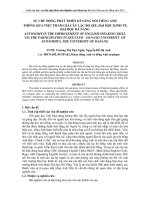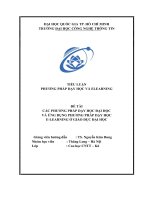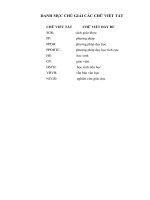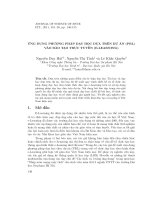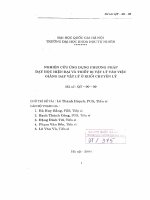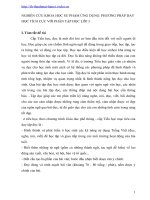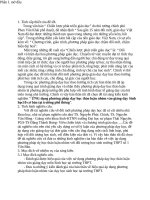Ứng dụng phương pháp dạy học dự án nhằm phát triển kĩ năng nói tiếng Anh cho học sinh lớp 10
Bạn đang xem bản rút gọn của tài liệu. Xem và tải ngay bản đầy đủ của tài liệu tại đây (1.38 MB, 94 trang )
THAI NGUYEN UNIVERSITY
SCHOOL OF FOREIGN LANGUAGES
VU THI HONG VAN
APPLYING PROJECT-BASED LEARNING
TO IMPROVE ENGLISH SPEAKING SKILLS
FOR THE TENTH GRADE STUDENTS
(Ứng dụng phương pháp dạy học dự án nhằm phát triển
kĩ năng nói tiếng Anh cho học sinh lớp 10)
M.A. THESIS
Field: English Linguistics
Code: 8220201
THAI NGUYEN - 2020
THAI NGUYEN UNIVERSITY
SCHOOL OF FOREIGN LANGUAGES
VU THI HONG VAN
APPLYING PROJECT-BASED LEARNING
TO IMPROVE ENGLISH SPEAKING SKILLS
FOR THE TENTH GRADE STUDENTS
(Ứng dụng phương pháp dạy học dự án nhằm phát triển
kĩ năng nói tiếng Anh cho học sinh lớp 10)
M.A. THESIS
(APPLICATION ORIENTATION)
Field: English Linguistics
Code: 8220201
THAI NGUYEN - 2020
DECLARATION
I, Vu Thi Hong Van, certify that the thesis named “Applying Project-Based
Learning to improve English speaking skills for the tenth-grade students”
performs the result of my own study for Degree of Master of Art at School of
Foreign Languages, Thai Nguyen University. I also declare that the thesis has not
been submitted for any degree to any other universities or institutions.
Thai Nguyen, 2020
Student
Vu Thi Hong Van
i
ACKNOWLEDGEMENTS
But for the invaluable help and constant support from a lot of people, the
thesis could not have been completed.
First of all, I would like to sincerely thank my supervisor, Nguyen Thi
Quyet, Ph.D for her persistent consideration, remarkable comments and enthusiastic
encouragement.
Secondly, I am also very grateful to all the teachers and tenth-grade students
at Nguyen Hue High Scholl for their wholehearted support in my lessons,
enthusiastic participation in tests and immediate reply to my survey questionnaires.
Last but not least, I want to give my deepest gratitude to my family and
friends who are always willing to help me in my writing process with their great
sympathy and considerable encouragement.
ii
ABSTRACT
In today’s trend of international integration, English is considered as a means
for learners to have fastest access to the world’s cultures and knowledge. The
teaching and learning of English need to be renewed in accordance with positive
learning methods to be more suitable and meet the needs of society. Project-Based
Learning is regarded as one of those effective teaching methods.
In an effort to improve English speaking skills for students in grade 10 at
Nguyen Hue High School by applying Project-Based Learning, this research solved
two questions: (1) the attitude of students toward the use of Project Based Learning
in their English lessons; (2) the effects of applying Project-Based Learning to
students’ English speaking skills. There were two tests and questionnaires for the
students in grade 10, an interview with six students to be selected as the tools for
data collection and analysis of the study. Researching finding presented that the
students taking part in lessons applied Project-Based Learning had positive
attitudes. Besides, it was exposed the advantages of Project-Based Learning which
offered benefits to improvement in the students’ speaking English skills. According
to the findings, there would be some implications to be given for the teachers as
well as the students. With all these data, this research is expected to be effective in
helping both teachers and students in teaching and learning English speaking skills.
Keywords: Project-Based Learning (PBL), speaking skills, high students
iii
LIST OF ABBRVIATIONS
%
Percent
CEFT
Common European Framework of Reference for Languages
CLT
Communicative Language Teaching Approach
EFL
English as a Foreign Language
PBL
Project-Based Learning
Ss
Students
T
Teacher
iv
LIST OF CHARTS AND TABLES
Table
Table 1: The results of pre-test and post-test ............................................................ 35
Chart
Chart 1.1:
Students’ mean score of average mark ............................................... 37
Chart 1.2:
A comparison of mean scores on pre-test and post-test by five criteria........ 37
Chart 2.1:
Students’ attitudes towards Project-Based Learning .......................... 38
Chart 2.2.1: Students’ ideas on the advantages of Project-Based Learning ........... 39
Chart 2.2.2: Students’ ideas on the advantages of Project-Based Learning in
learning speaking skills ....................................................................... 40
Chart 2.3:
Students’ difficulties when implementing Project-Based Learning ......... 41
v
TABLE OF CONTENTS
DECLARATION ......................................................................................................... i
ACKNOWLEDGEMENTS ........................................................................................ii
ABSTRACT .............................................................................................................. iii
LIST OF ABBRVIATIONS ...................................................................................... iv
LIST OF CHARTS AND TABLES ............................................................................ v
TABLE OF CONTENTS ........................................................................................... vi
PART 1. INTRODUCTION ..................................................................................... 1
1. Rationale of the study .......................................................................................... 1
2. Significance of the study ..................................................................................... 3
3. Research aim and objectives ............................................................................... 3
4. Research questions ............................................................................................... 4
5. Methods of the study ........................................................................................... 4
6. Scope of the study ................................................................................................ 4
7. Structure of the study ........................................................................................... 5
PART 2. DEVELOPMENT...................................................................................... 6
CHAPTER 1. THEORETICAL BACKGROUND AND LITERATURE REVIEW ....... 6
1. Speaking skills ..................................................................................................... 6
1.1. Definition of speaking skills ......................................................................... 6
1.2. Functions of speaking ................................................................................... 7
1.3. The importance of teaching speaking skills ................................................. 8
2. Communicative Language Teaching Approach .................................................. 9
3. Project-Based Learning ..................................................................................... 11
3.1. Definitions of Project-Based Learning ....................................................... 11
3.2. Key features of Project-Based Learning..................................................... 12
3.3. Stages in project work ................................................................................ 14
3.4. Teacher’s and students’ roles in Project-Based Learning .......................... 15
4. Project-Based Learning in speaking skills ......................................................... 17
5. Previous studies ................................................................................................. 18
vi
CHAPTER 2. RESEARCH METHODOLOGY .................................................. 22
1. Methods of research ........................................................................................... 22
2. Setting of the study ............................................................................................ 23
3. Participants......................................................................................................... 25
4. Research design ................................................................................................. 25
5. Data collection procedure .................................................................................. 26
6. Data collection instruments ............................................................................... 31
7. Data analytic method ......................................................................................... 33
CHAPTER 3. FINDINGS AND DISCUSSION ................................................... 35
1. Analysis of the speaking tests ............................................................................ 35
2. Students’ evaluation of the application of Project-Based Learning .................. 38
2.1. Students’ attitudes towards Project-Based Learning .................................. 38
2.2. Students’ ideas on the advantages of Project-Based Learning ................... 39
2.3. Students’ opinions on the difficulties when implementing ProjectBased Learning ................................................................................................. 41
3. Analysis of the interview ................................................................................... 42
3.1. The benefits of Project-Based Learning ..................................................... 42
3.2. Students’ opinions on the drawbacks of Project-Based Learning .............. 43
4. Discussion of the findings ................................................................................. 44
4.1. Achievement ............................................................................................... 44
4.2. Students’ review of the application of Project-Based Learning ................. 45
5. Summary ............................................................................................................ 47
PART 3. CONCLUSION ........................................................................................ 49
1. Recapitulation of the research ........................................................................... 49
2. Recommendations of the study .......................................................................... 50
2.1. The teachers ................................................................................................ 50
2.2. The students ................................................................................................ 50
2.3. The school administrators ........................................................................... 50
3. Limitations of the study ..................................................................................... 51
4. Suggestions for further research ........................................................................ 51
vii
REFERENCES .......................................................................................................... 53
APPENDICES ............................................................................................................. I
Appendix 1 - A SAMPLE DESCRIPTION OF A PROJECT ................................ I
Appendix 2 - THE PRE-TEST FOR STUDENTS ............................................ XIII
Appendix 3 - THE POST-TEST FOR STUDENTS ........................................... XV
Appendix 4 - RATING SCALE FOR SPEAKING TEST ............................... XVII
Appendix 5 - THE QUESTIONNAIRE FOR STUDENTS ..............................XXI
Appendix 6 - INTERVIEW QUESTIONS ...................................................... XXV
Appendix 7 - TRANSCRIPTS OF THE INTERVIEWS ................................ XXVI
viii
PART 1. INTRODUCTION
In this part, the writer mentions the background to the problems and the
reasons for choosing the topic. As a consequence, the necessity of delivering the
research and the importance of the application of project-based teaching in
teaching English speaking skills is revealed. The aims and the significances of the
study are also stated. The final section will show the scope and methods of the study
which presents the number of participants and the time of the intervention.
1. Rationale of the study
As globalization has an enormous influence on the world’s economy,
politics, culture, society and education, English has become the most important
international language and widely used all over the world. In Vietnam, English has
been known as a vital foreign language which improves Vietnamese people’s life
style as well as living standard with greater employment and job promotion with
high salary, especially overseas study opportunities. Recognizing the importance of
English, the Vietnam government has planned to introduce English to be taught
from elementary school to university and to be a compulsory subject in General
Certificate Secondary Education. Besides, Ministry of Education and Training has
had many solutions in order to improve the quality of English teaching and learning.
We have carried out many changes and renovations in national curriculum, teaching
methodology, testing and assessment as well as other conditions to assert these tasks
to be done successfully.
The core content of English teaching and learning helps students build and
develop communication skills through practicing listening, speaking, reading,
writing and linguistic skills (phonetics, vocabulary, grammar). Hence, one of the
main approaches in English general curriculum is the communicative approach. The
goal of communicative language teaching is to develop learners’ communicative
competence (Nunan, 1988). It is clear that to communicate effectively in one
language; English speaking skills should be developed along with the other skills so
that these integrated skills will enhance communication achievement both with
1
English native speakers and other members of the international community. Due to
the significant role of speaking in learning English, Bailey (2005) described how to
enhance the development of speaking by means of syllabus design, principles of
teaching, types of tasks and materials, and speaking assessment.
Methodology used in teaching second language has experienced many
changes for decades; however there is no single best method, and no one method
that is best for a particular classroom. Each classroom has distinct goals and
learners; therefore there are lots of foreign language teaching methods to be applied
with different approaches and different purposes. As a result, the best language
teaching methods depends on learning styles, particular contexts, stages of teaching,
learning process and the goals of learning (Brown, 2000). Among the numerous
methods based on communicative language teaching, Project-Based Learning (PBL)
has been considered to be an effective method in enhancing learners’ motivation.
This method lets students explore actively, creates authentic language and uses
language in real life situations. The method also encourages student-centered
classes that focus on developing skills for lifelong learning and collaboration among
students working on either small groups or as a class.
In Nguyen Hue High School - a small school in a low living standard
mountainous commune, a seven-year English teaching program for students has
been implemented since 2007. The Ministry of Education and Training sets the goal
for junior high school students in English proficiency to reach Level 3 according to
the 6-level foreign language competence framework for Vietnam, which means that
students are able to communicate in everyday situations with commonly-used
expressions and elementary vocabulary. However, teachers’ and students’
remarkable difficulties, such as: no integration of the four skills in teaching and
learning, insufficient practice time allowed, teachers’ lack of training in the
practical skills of teaching to English as a foreign language learners, students’ poor
practice skills and low confidence or inadequate teaching equipment and facilities,
and etc. Hence, it is vital to apply a new and effective technique to improve
students’ English learning, particularly enhance their speaking skills.
2
Based on the explanation above, the writer is engrossed in conducting an
experimental research entitled: “Applying Project-based learning to improve
English speaking skills for the tenth-grade students” to stimulate the English
speaking skills for the tenth-grade students at Nguyen Hue High School.
2. Significance of the study
Theoretically, this study is a small contribution to the theory of English
Language Teaching on the effects of applying Project-Based Learning on improving
students’ language competence of speaking skills at a high school. Several previous
studies have also demonstrated that Project-Based Learning has positive effects on
students’ speaking skills. Hopefully, this research supports the theory of ProjectBased Learning as well as achieves rewarding results.
Practically, the study is firstly hoped to be an effective alternative way to let
out students to more student-centered classrooms, and to help them improve their
English competence, cooperation and their motivation in these classes. The researcher
expects to provide useful information and experience with English teachers whether
or not Project-Based Learning becomes one of the most effective methods to develop
students’ speaking skills. With optimistic expectations, it might possibly be widely
applied at a high school in order to make students interested in English speaking and
more confident to communicate with each other in the target language.
To sum up, this study is built up to explore previous related theories to get
background knowledge of Project-Based Learning along with to change and
promote educational situations.
3. Research aim and objectives
The aim of this study is to enhance speaking skills for the tenth grade
students by applying Project-Based Learning.
To achieve the above objectives, the present research attempts to set the
following objectives:
- To find out whether Project-Based Learning can encourage the 10th form
students to improve their speaking skills or not.
- To investigate the attitudes of the tenth-grade students towards the
application of Project-Based Learning to their English speaking lessons.
3
4. Research questions
This research tries to explore the usefulness of applying Project-Based
Learning in teaching to improve speaking skills for senior high schools. The areas
of investigation are formulated in the following research questions:
1. To what extent does Project-Based Learning improve the students’
speaking skills?
2. What are the students’ attitudes towards Project-Based Learning?
5. Methods of the study
The method employed in the study is action research, in which ProjectBased Learning would be used directly in the class that the researcher is teaching.
Besides, both qualitative and quantitative data collection and analysis methods are
applied into this research.
In term of qualitative method, the researcher use
interviews to gather students’ opinions toward PBL activities in class. In term of
quantitative method, questionnaires and tests are applied. The results from the
questionnaire and interviews will be regarded to the students’ general attitude
toward PBL, their perception on the effectiveness of Project-Based Learning on
their speaking levels as well as speaking skills. Means of pre-test and post-test
scores would be counted to decide the effects of Project-Based Learning on the
students’ speaking scores. Both the methods are cooperative to each other. At the
same time, the results from the speaking scores would be compared with the data
collected in the interviews and questionnaire.
6. Scope of the study
The study mainly focuses on the influence of Project-Based Learning on
speaking skills of students within the context of teaching and learning English as an
optional subject at Nguyen Hue High School.
This research is carried out in English-specialized class with 40 tenth grade
students at Nguyen Hue High School in the second term of the school year 2019-2020.
4
7. Structure of the study
The study is divided into three parts.
Part 1 - Introduction relates to the rationale for the research. Besides, it
shows the significance of the study, the aims and objectives, research questions, the
scope, the methods and the design of the study.
Part 2 - Development has three chapters.
Chapter 1 - Theoretical background and literature review supplies an
overview of theoretical background and previous studies involved in the research topic.
Chapter 2 - Research Methodology describes the methods used for this study,
data collection instruments, data collection procedures and data analysis procedure.
Chapter 3 - Findings and Discussion provides the findings and discussion
of the research based on results of the action research methodology.
Part 3 - Conclusion comes up with the summary and limitations of the study
and adds some suggestions for further studies.
5
PART 2. DEVELOPMENT
CHAPTER 1. THEORETICAL BACKGROUND AND LITERATURE REVIEW
In this chapter, the literature on speaking skills, Communicative Language
Teaching Approach and Project-Based Learning is described briefly. In addition, it
also mentions how Project-Based Learning helps promote students’ speaking skills
in the classroom.
1. Speaking skills
1.1. Definition of speaking skills
Out of the four language skills, speaking is regarded as the means which
learners can communicate with others in order to gain certain aims or to express
their ideas, intentions, wishes, viewpoints and so on. Besides, people who know a
language are referred to as speakers of this language. Therefore, many authors have
come up with different definitions of speaking.
Byrne (1984:8) states that speaking is oral communication. It is a two-way
process between speaker and listener and involves productive and receptive skills of
understanding. Hence, there must be at last two participants in the process of speaking;
they are a speaker who gives information and a listener who receives information.
Meanwhile, Chaney (1998:13) considers speaking as “the process of building
and sharing meaning through the use of verbal and nonverbal symbols, in a variety
of contexts. Speaking is a crucial part of second language learning and teaching.”
This indicates students are able to communicate with other so as to get or share
information as well as express what they think or feel.
Moreover, Wilson (1983:5) defines speaking as “development of the
relationship between speaker and listener. In addition speaking determining which
logical linguistic, psychological a physical rules should be applied in a given
communicate situation”. It implies that speaking is one of the central elements of
communication of an interactive process in which an individual alternately takes the
roles of speakers and listeners used to communicate information, ideas, and emotions
to others using oral language. Consequently, the quality of students’ speaking is
6
influenced by the situation of students’ emotion; whether it is fluency or structure.
The primary object of speaking is to communicate. Therefore, to deliver the opinion
efficiently the speaker is supposed to understand the meaning of all information that
will be conveyed, he has to evaluate the impact of communication on the listener, and
he has to comprehend the principle that makes up the basis of communication.
Other perception originates from Brown (1994) of which speaking is an
interactive process of constructing meaning that involves producing, receiving and
processing information. There are three significant points within the definition of
speaking skills. First, by productive skill is concerned with the ability of a person to
actively produce the language by matching the organs of speech such as the lips,
tongue, teeth, vocal cords, larynx, pharynx, etc. Second, to express meaning refers
to the purpose of producing language in verbal communication is to give opinions
and experiences in order that the speaker can convey meaning to the listener and
others. Third, being able to be directly and empirically observed means that the
implementation of speaking can be directly heard or seen and empirically measured
in the speaking process by looking at the accuracy and efficiency of the speaker.
From experts’ statements detailed above we can draw a conclusion that
speaking is a process of oral activities produced in daily life as an important part of
communication in which verbal and nonverbal signs are used in sending and
receiving messages.
1.2. Functions of speaking
According to the standard competence of speaking, learners are able to
express the meaning of formal and constant transactional and interpersonal
conversation in their daily life. Transactional conversation as well as interpersonal
conversation is called interpersonal functions of speaking, in which it helps to build
and maintain social relations, and the transactional functions, which concentrates on
the exchange of information. Therefore, Jack C. Richards (2008: 21) states three
functions of speaking to succeed a communicative goal through speaking, they are:
talk as interaction, talk as transaction and talk as performance. In terms of form and
functions, each of these communication activities is different and obviously needs
different approaches of teaching. Brown and Yule (1983) defines that as follow:
7
“Talk as interaction refers to what we normally mean by “conversation” and
describes interaction that serves a primarily social function. The focus is more on the
speakers and how they wish to present themselves to each other than on the message.”
“Talk as transaction refers to situations where the focus is on what is said or
done. The message and making oneself understood clearly and accurately is the central
focus, rather than the participants and how they interact socially with each other.”
“Talk as performance refers to public talk, that is, talk that transmits
information before an audience, such as classroom presentations, public announcements,
and speeches.”
In English classes, three main issues are necessary to be solved in designing
speaking activities, and the researcher detected that PBL was actually an
opportunity for students to achieve all types of talks.
1.3. The importance of teaching speaking skills
In this globalized world, speech plays a great role in our daily lives, for
instances if we want to fulfill our desires and deeds; there is a need to share our
ideas and thoughts with the people living around the world. Particularly, in
classrooms where students’ ability to speak second or foreign languages fluently
with the target language is the first priority, speaking is an important skill which
deserves more attention in both first and second language because it reflects
people’s thoughts and personalities.
Speaking is an interactive task and it takes place under real time processing
compulsions, which means that learners will be able to use words and phrases
fluently without very much conscious thought. Harmer (2001: 271) states that
effective speakers need to be able to process language in their own heads and put it
into coherent order so that it comes out in forms that are not only comprehensible,
but also convey the meanings that are intended. One of the reasons for including
speaking activities in language lessons is to help students get accustomed to oral use of
language in English conversation. Speaking activities supply exercise opportunities in
real life speaking in the safety classroom.
8
Furthermore, teaching speaking is a very important part of second language
learning. The ability to communicate in a second language clearly and efficiently
contributes to the success of the learner in school and success later in every phase of
life. Therefore, it is important that language teachers take notice of teaching speaking,
rather than leading students to pure memorization, providing a rich environment
where meaningful communication takes place is desired. With this aim, ProjectBased Learning can contribute a great deal to students in term of getting successful in
three core functions of speaking. Additionally, Project-Based Learning assists
students in improving basic skills necessary for life. These activities in Project-Based
Learning encourage students become more active in the learning process and at the
same time keep their studying more meaningful and enjoyable.
2. Communicative Language Teaching Approach
Throughout the history of learning and teaching languages with many
distinct approaches, such as: Grammar - Translation Method, Audio lingual
Method, the Total Physical Response, the Natural Approach, and so on,
Communicative Language Teaching is the latest effect on teaching methodology
which has been worldwide applied as an innovative and efficient approach to teach
English as a second or foreign language.
Since the 1970s when CLT emerged as an approach to second language
pedagogy, there have been a number of researchers, educators and language
practitioners began reflecting and discussing the notion of communicative
competence. According to Savignon (1984), CLT means different things to the
different people who practice it. Savignon along with other language teachers
started looking for an alternative to the Audio-lingual Method in the 1970s and
gradually moved towards CLT. In his research made in 1972, he showed that
students who had some regular amount of CLT in addition to audio-lingual teaching
learned better than students who had audio-lingual teaching only. The audio-lingual
method proposes that students learn from repetition and habit formation, but it
includes very little, if any, chances for real communication. Then CLT has become
a favored research area, yet there is a limitation on understanding and practice
among teachers and learners.
9
Nunan (1989: 194) also considers this method as a system for the expression
of meaning. Activities involve oral communication, carrying out meaning tasks and
using language, which is meaningful to the learners. Objectives reflect the needs of
the learners; they include functional skills as well as linguistic objectives. The
learner’s role is as a negotiator and integrator. The teacher’s role is as a facilitator of
the communication process. Materials promote communicative language use; they
are task-based and authentic.”
Additionally, Brown (2007: 378) states CLT as “an approach to language
teaching methodology that emphasizes authenticity, interaction, studentcentered learning, task based activities, and communication for the real world,
meaningful purposes”.
Furthermore, Brown (2007: 241) also gives four interrelated features of CLT:
Classroom goals are focused on all of the components of CC (communicative
competence) and not restricted to grammatical or linguistic competence.
Language techniques are designed to engage learners in the pragmatic,
authentic, functional use of language for meaningful purposes. Organizational
language forms are not the central focus but rather aspects of language that enable
the learner to accomplish those purposes.
Fluency and accuracy are seen as complimentary principles underlying
communicative techniques. At times fluency may have to take on more importance
than accuracy in order to keep learners meaningfully engaged in language use.
In the communicative classroom, students ultimately have to use the
language, productively and receptively, in unrehearsed contexts.
In brief, CLT is affirmed to be the most used and well-known approach to
help students communicate effectively. Among many distinctive characteristics,
learner-centered and experience-based teaching process becomes one of the most
outstanding features. Through CLT, students develop fluency and accuracy, use the
four skills interchangeably as they exist together in the real world, and generate and
discover grammatical rules. Additionally, students learn the target language through
listening to other members in group activities. Students also learn more vocabulary
items and grammatical patterns as well as enjoy increased motivation levels in pair
or group work activities rather than in a teacher-centered classroom.
10
3. Project-Based Learning
3.1. Definitions of Project-Based Learning
The initial of PBL can be concerned with the progressive tradition advocated
by John Dewey. Dewey mainly concentrated on the idea of “learning by doing”. He
also argued that the classroom should be a kind of society and in the learning
process the students should be encouraged to become the center.
Further developments of the Project-Based education as a pedagogy later
were based on the experience- and perception-based theories on education proposed
by various theorists.
According to Haines (1989: 1), PBL is defined as follows:
“… [Projects are] multi-skill activities focusing on topics or themes rather
than on specific language targets. Of crucial importance is the part which the
students themselves play in the initial choice of subject matter and in the decisions
related to appropriate working methods, the project timetable and the eventual “end
product”. Because specific language aims are not prescribed, and because students
concentrate their efforts and attention on reaching an agreed goal, project work
provides students with opportunities to recycle known language and skills in a
relatively natural context. Projects can be intensive activities which take place over
a short period of time, or extended studies which may take up one or two hours a
week for several weeks”.
Besides, Fried-Booth (1986:8) uses the term “project” with a view to
indicating that language tasks arise naturally from the project itself, “developing
cumulatively in response to a basic objective, namely, the project.”
Moreover, Hedge (1993) characterizes projects as extended tasks which
usually integrate language skills by means of a number of activities. These activities
combine in working towards an agreed goal and may include the following:
planning, the gathering of information through reading, listening, interviewing, and
observing; group discussion of information; problem solving; oral and written
reporting; and displaying.
11
It is also defined as “an instructional approach that contextualizes learning
by presenting learners with problems to solve or products to develop” (Moss &
Van Duzer, 1998). As the result, project work brings many chances for students
to use and stimulate their creativity, critical thinking, collaboration, self-study,
and other study skills.
Whereas Katz & Chard (2000) show that Project-Based Learning is a very
efficient approach which lets the students throw out opinions about the topics
covering fields of interest, ask questions, estimate, develop theories, use different
tools, use the skills achieved in the context of a real and meaningful life and
encourages learners to solve problems and answer questions in a creative way in the
classroom and outside.
It is clear that the definition of PBL is changing from time to time. However,
there is a conclusion drawn from the above definitions is that Project-Based
Learning is capturing learning experiences that affect students in complex, realworld projects through which they advance and apply both skills and knowledge.
The outcomes can be recognized up front but occasionally are only experiences to
assign resources such as materials or time.
3.2. Key features of Project-Based Learning
The features of PBL appear to be consistent among educators and researchers
who studied and applied this teaching method. Stoller’s (2007:4-5) assembled study
for the common characteristics of PBL as follows:
1. Project work focuses on content learning rather than on specific language
targets. Real-world subject matter and topics of interest to students can become
central to projects
2. Project work is student-centered, though the teacher plays a major role in
offering support and guidance throughout the process
3. Project work is cooperative rather than competitive. Students can work on
their own, in small groups, or as a class to complete a project, sharing resources,
ideas, and expertise along the way.
12
4. Project work leads to the authentic integration of skills and processing of
information from varied sources, mirroring real-life tasks.
5. Project work culminates in an end product (e.g., an oral presentation, a
poster session, a bulletin board display, a report, or a stage performance) that can
be shared with others, giving the project a real purpose. The value of the project,
however, lies not just in the final product but in the process of working towards the
end point. Thus, project work has both a process and product orientation, and
provides students with opportunities to focus on fluency and accuracy at different
project-work stages.
6. Project work is potentially motivating, stimulating, empowering, and
challenging. It usually results in building student confidence, self-esteem, and
autonomy as well as improving students’ language skills, content learning, and
cognitive abilities.
From the key features of Project-Based Learning, there is a wide range of
benefits to students along with teachers to be more explained. A growing body of
academic research takes care of the application for Project-Based Learning in
schools in order to engage students, reduce absenteeism, improve cooperative
learning skills and stimulate academic performance (George Lucas Educational
Foundation, 2001).
In Project-Based Learning, students are allowed to choose project topics. For
a project to have the required scientific level, students must be very serious when
performing. They must be given responsibility as well as opportunity to
demonstrate their ideas and be involved in the decision process in which the project
is selected. At the beginning of the project, students will tend to explore, and desire
the need to choose a topic or research issues so as to create openness. This will
make learning difficult to predict, which is a primary feature of Project-Based
Learning. Through research and exploration, students will acquire metacognitive
skills, such as: analyzing new problems, finding and deciding to select information,
summarizing, reporting, or drawing conclusions. Additionally, each topic begins
with the real world in which they live, which creates inspiration for them to carry
13
out the project. The children’s world is imaginative and formed through the society
in which they live. Every time makes a difference. That is the reason why ProjectBased Learning is a unique, diverse and highly effective way of learning.
Meanwhile, teachers gain numerous benefits like enhance professionalism
and collaboration among colleagues, and opportunities to build relationships with
students (Thomas, 2000). Furthermore, a lot of teachers are satisfied to achieve a
model that accommodates different learners by proposing a wider range of learning
opportunities into the classroom.
In a nutshell, Project-Based Learning is a style of active learning and
inquiry-based learning. It contrasts with paper-based, rote memorization, or teacherled instruction that simply shows established fact or portrays a smooth path to
knowledge by instead posing questions, problems or scenarios.
3.3. Stages in project work
The implementation of Project-Based Learning was done in four stages.
They are speculation, designing the project activities, conducting the project
activities, and evaluation.
The first stage called speculation consists of selection of project theme and
sensitization about it, focusing on exciting interest and stimulating a climate
conductive to speculation and dialogue among all groups’ members and the teacher.
The initial stimulus may emerge from the curriculum, or after a discussion about a
contemporary local or wider topic of interest, or from reading a newspaper or
magazine article (Brinia, 2006: 79).
The second stage, which is designed the project activities, includes formation
of groups and assigning of roles, decisions concerning methodology, sources of
information, activities that will take place, and places outside the classroom that
students will visit. The better organized and more analytical the structuring of the
activities, the easier and faster the research will be conducted (Fragoulis, 2008).
The third stage known as conducting the project activities shows that the
groups implement the activities designed in the previous stage. Students gather
information, process and categorize it. If deemed necessary, there may be intervals
14
of information and feedback, in which students discuss issues related with
cooperation among group members, problems of personal relations, and possible
changes in group composition.
The next phase is synthesis and processing of information gathered. The final
products are displayed in the school or the wider community, and become a
stimulus for thought and action for other students, teachers and local community.
The project moves away from school and becomes social intervention, connecting
the school with the community and real life (Fragoulis, 2008:35).
The fourth stage considered evaluation refers to the assessment of the
activities from participants and discussion about whether the initial aims and goals
have been achieved, implementation of the process, and final products (Brinia,
2006:82). Evaluation also entails assessment of the experience at individual and
group level, identification of errors and problems, but also appraisal of the rich
cognitive and experiential material gathered. Evaluation includes evaluation from
others, as well as self-evaluation.
Although there are many studies focusing on the theoretical underpinnings
for project-based learning in foreign language teaching, there are relatively few
empirical studies linking theory with practice, evaluating the impact of project
work in the context of foreign language instruction. In this context, our study
examines the practical aspects of implementing project work in primary school
settings, reporting difficulties encountered, benefits from project work, and
pedagogical implications.
3.4. Teacher’s and students’ roles in Project-Based Learning
Ideally, the students are people who decide their projects, but because in
lower-level classes students often lack the required language skills or confidence to
promote project themes, the teacher has to listen to them and manage to describe
some underlying issues that are significant to the students, as well as take notice of
their needs, interests, cultural background, jobs, etc.
In classrooms with beginner level students, the teacher may have to take a
fairly active role, supplying examples of previously completed projects to boost the
15

